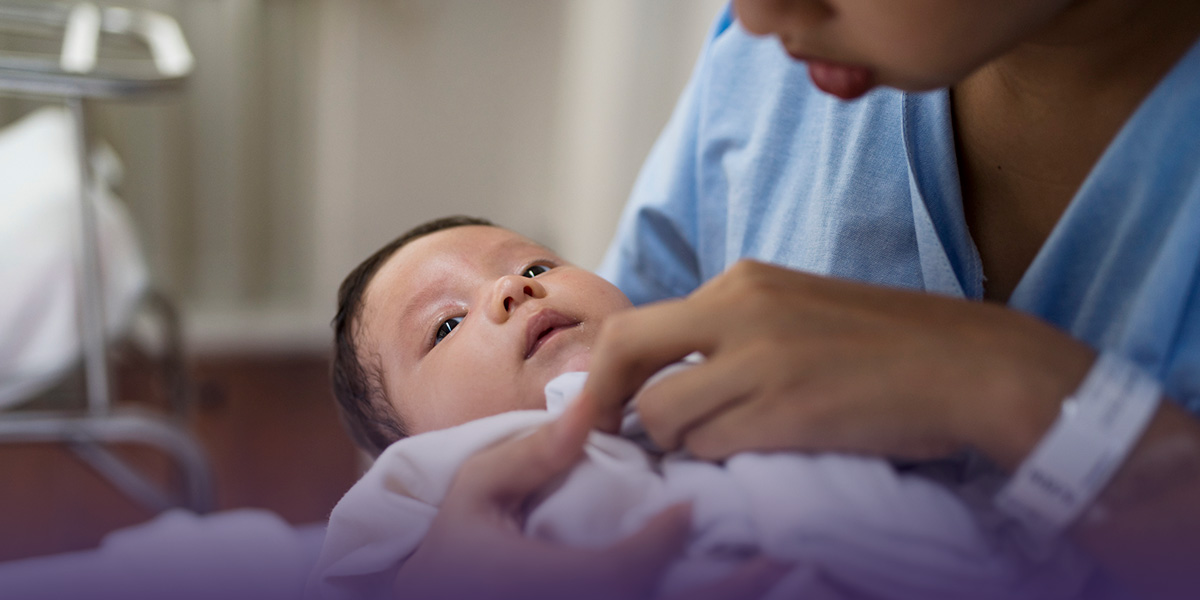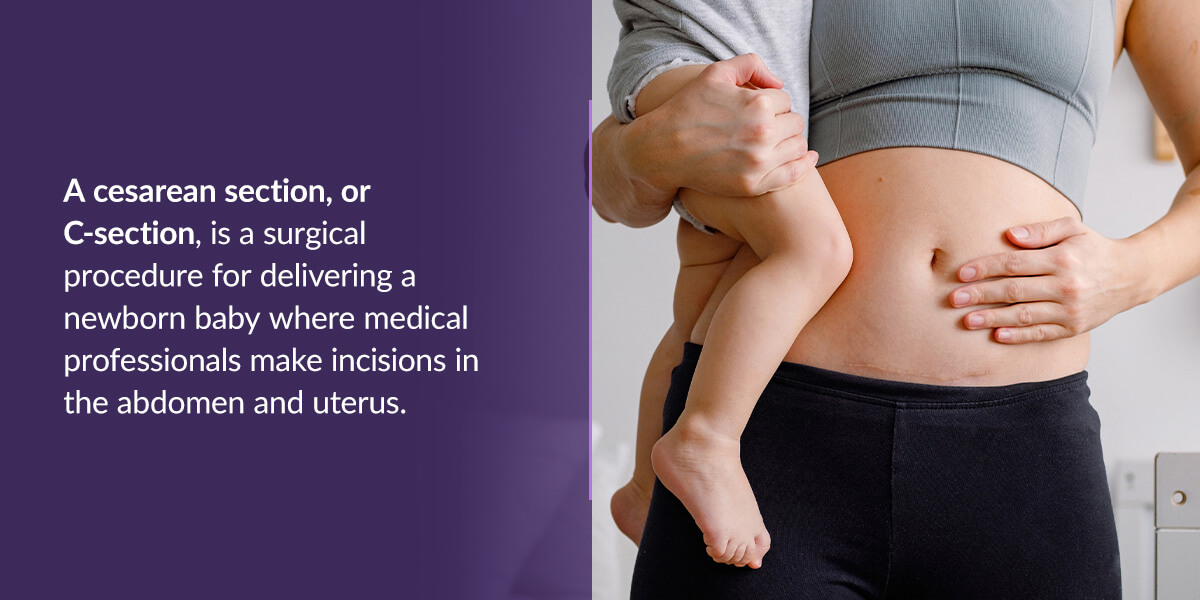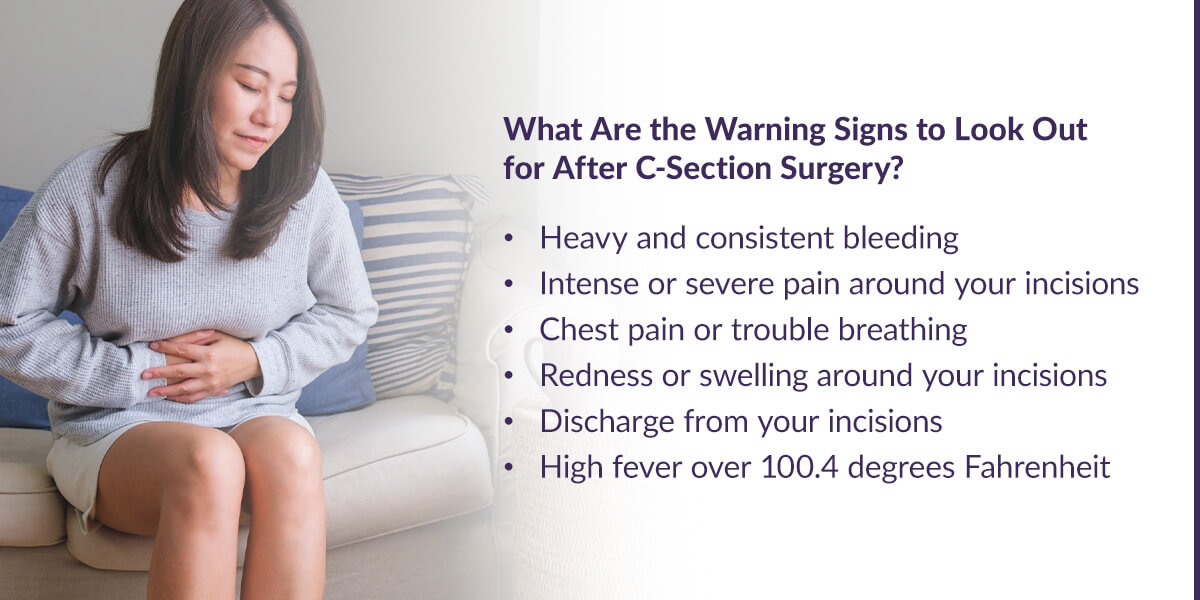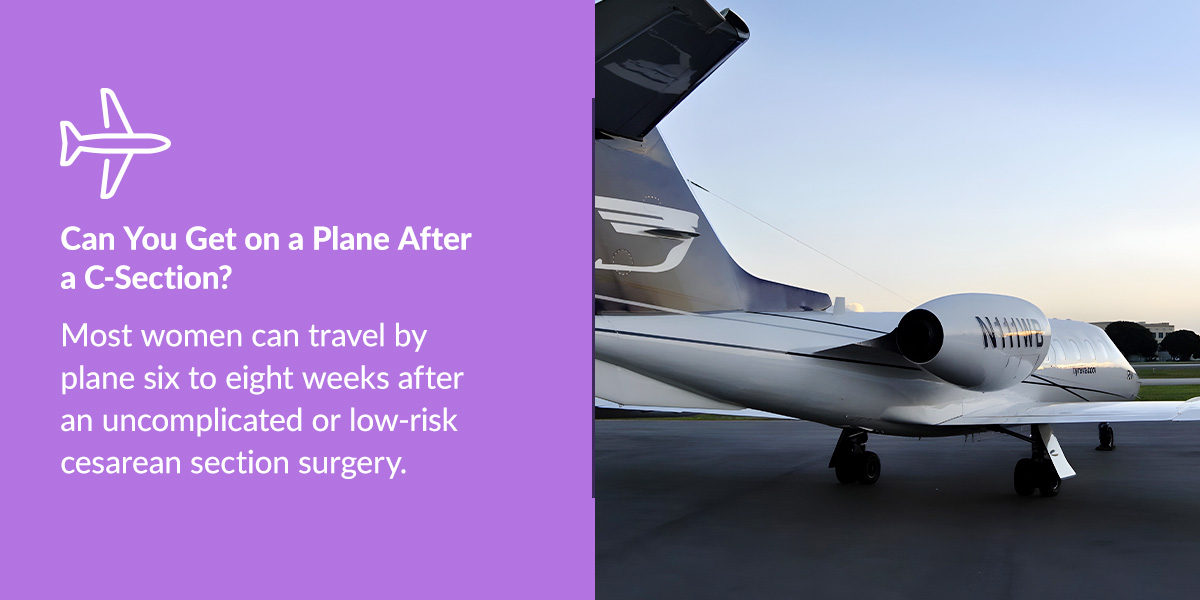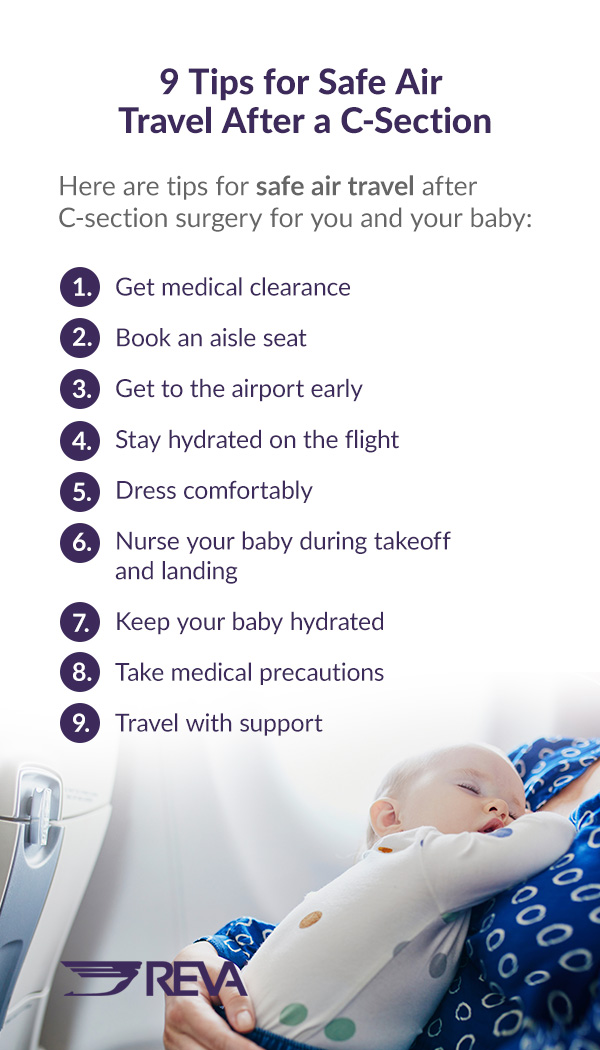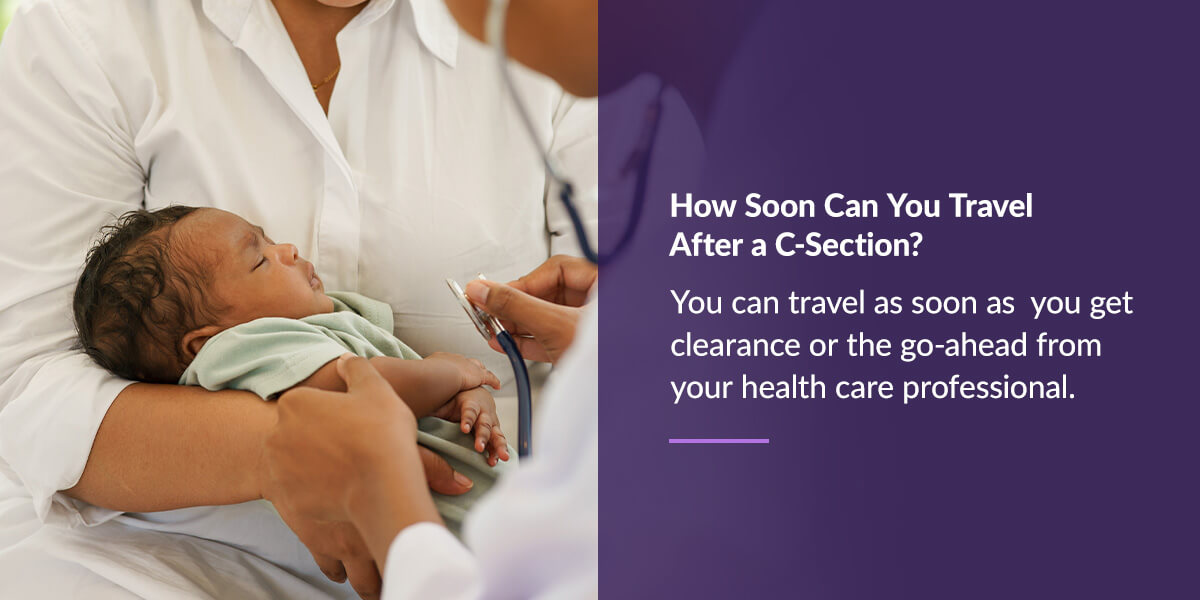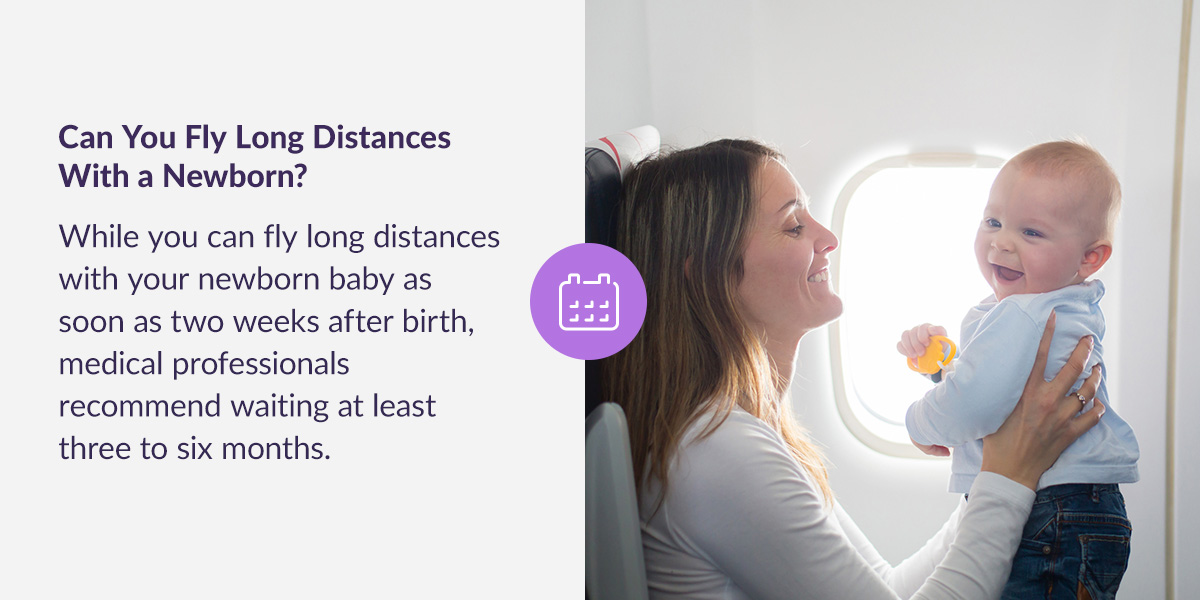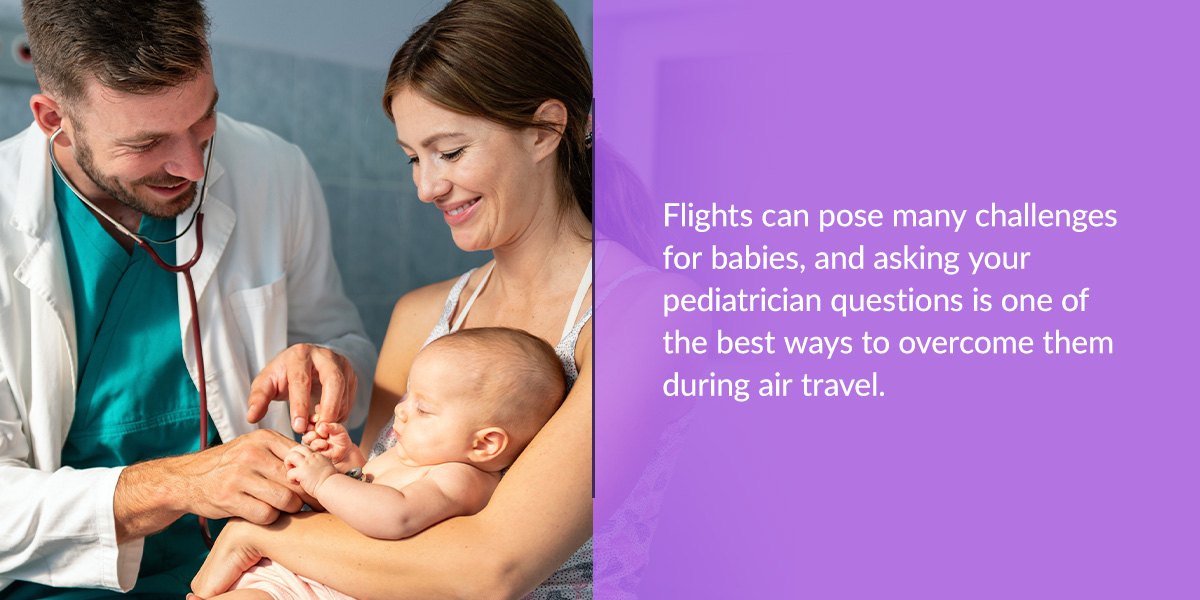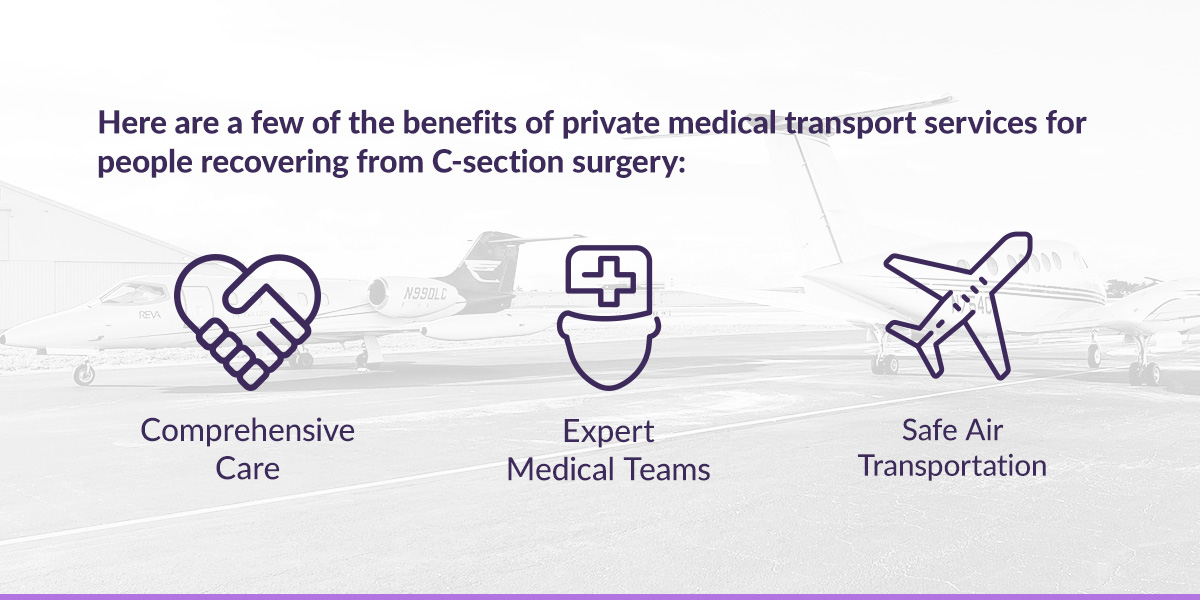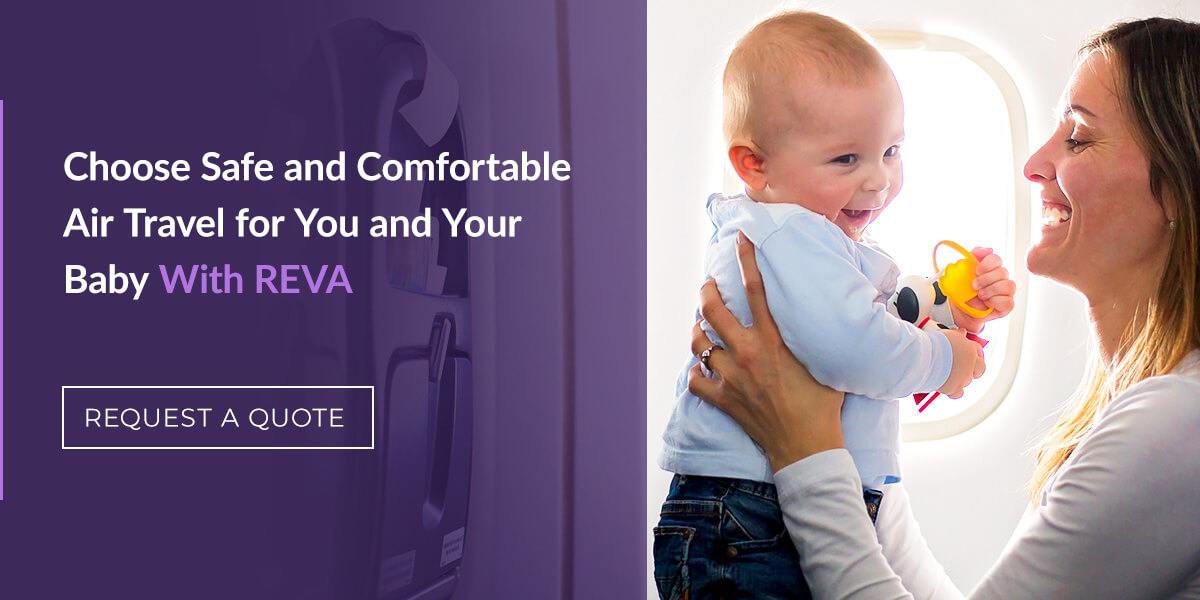How Soon Can You Fly After a C-Section?
Taking a first family trip with your new baby is likely something you’ve looked forward to throughout your entire pregnancy. However, if you underwent — or will undergo — a cesarean section to deliver your baby, you’ll want to make sure you’ve recovered before getting on a plane. As with any other surgery, a C-section comes with risks and complications, and traveling too soon or without taking the proper precautions can put you at risk.
Explore how soon new mothers can fly after giving birth and some tips for flying safely and comfortably.
What Is a Cesarean Section?
A cesarean section, or C-section, is a surgical procedure for delivering a newborn baby where medical professionals make incisions in the abdomen and uterus. There are a few different types of incisions:
- Low transverse: The low transverse incision curves horizontally across the lower abdomen.
- Low vertical: This incision extends vertically down the lower abdomen.
- High vertical: Similar to the low vertical incision, this incision extends vertically, but it’s made higher on the abdomen and along the stomach.
The incision you receive differs depending on the position of your baby and the length of your pregnancy. The low transverse incision is ideal, as it often heals quickly and gives doctors a good view of the lower uterus. The low vertical incision may be a good option for babies positioned sideways, bottom first or feet first, and a high vertical incision is best for pre-term babies or in cases where an emergency C-section is needed.
Regardless of the operation type, a C-section incision can often be 4-6 inches long, and C-section scars usually take a long time to heal.
What Are the Risks of C-Section Surgery?
C-sections are safe delivery procedures, but like any other major surgery, they come with some risks and complications, including:
- Womb lining infections that cause pain and swelling.
- Infections at the cut or wound.
- Opened stitches or scars.
- Excessive bleeding.
- Excessive pain and swelling.
- Blood clots and deep vein thrombosis (DVT) in the legs, organs or lungs.
What Are the Warning Signs to Look Out for After C-Section Surgery?
After your C-section, you’ll want to watch for the following signs that can indicate an issue or infection:
- Heavy and consistent bleeding
- Intense or severe pain around your incisions
- Chest pain or trouble breathing
- Redness or swelling around your incisions
- Discharge from your incisions
- High fever over 100.4 degrees Fahrenheit
How Long Does It Take to Recover From C-Section Delivery?
Many estimates suggest it takes four to six weeks to recover from a C-section. However, healing ultimately depends on the person, and some recovery periods may be longer.
C-section delivery can cause challenges like pain, cramps, bleeding, numbness, blood clots and infections during recovery, and these symptoms can prolong healing. Underlying health issues like diabetes can also impact the recovery period, as can complications like the stitches tearing or opening. Healing from a C-section is a delicate process, requiring care, rest and support. Here’s a brief recovery timeline:
- 24 hours after C-section: Your doctors and nurses will encourage you to get out of bed and walk around to get your intestines and digestive systems moving and prevent swelling. You may experience pain in the day after surgery.
- Week one: Patients often spend four days in the hospital before discharge. At home, rest and limited physical activity are vital. You may also experience pain and bleeding during this time.
- Two to five weeks: Your doctor will inspect your incisions at your postpartum visit, but you should call them first if you experience excessive pain, heavy bleeding, leg pain and swelling in the weeks following delivery.
- Six weeks and beyond: Your doctor will evaluate your recovery during your final postpartum check-up. Depending on your healing, they can advise as to whether you can resume daily activity. Rest is still essential — you’ll need to take it easy until you fully recover.
Can You Get on a Plane After a C-Section?
You can resume most regular activities four to eight weeks after your C-section. Most women can travel by plane six to eight weeks after an uncomplicated or low-risk cesarean section surgery. This travel recommendation is based on the risk of developing venous thromboembolism (VTE) while flying. VTE refers to blood clots in the veins, and the chances of developing VTE increase during pregnancy and after childbirth, specifically during the first six weeks postpartum.
The guidelines for traveling after a high-risk or complicated C-section can vary depending on your surgical outcomes and your recovery length. Medical considerations and clearance are necessary to decide if you are fit for flight post-surgery. It’s best to consult your health care professional before traveling by plane during cesarean section recovery.
What Are the Concerns of Flying Post-C-Section Surgery?
Worsening the symptoms and increasing the risks associated with C-sections are significant concerns when flying post-surgery. Flying can be strenuous, especially when airports are busy and flights are packed. Walking through airports, waiting in lines, carrying luggage and sitting uncomfortably for extended hours can strain a recovering body. Additionally, rest is essential during C-section healing, and traveling by plane can limit your sleep and rest.
Some risks of flying after a cesarean section can include:
Increased Swelling
Physical activity, like walking briskly through an airport, can strain your scars and wound area. This trauma can elevate swelling and inflammation at incision sites.
Stitches Opening
Excess pressure on your C-section wound can open or tear stitches. For example, carrying and lifting heavy luggage can over-exert your body and tug on your stitches.
Blood Clots
A surgical procedure, especially in your abdomen, can elevate your chances of a blood clot, and without proper intervention, blood clots can lead to pulmonary embolism. C-section procedures, specifically, can increase pressure in your leg and pelvic veins, sometimes causing deep vein thrombosis (DVT). Sitting for prolonged periods — as you do on planes — can also cause blood clots, making flying after surgery more risky.
Despite these facts, the chances of experiencing a blood clot can be low for healthy postpartum individuals, especially when you have space to stretch your legs and walk.
Dehydration
Dehydration is common on airplanes due to low humidity levels. It can especially be concerning for those prone to blood clots, like postpartum people, as dehydration can impact the circulation and thicken the blood.
Barotrauma
Like physical pressure, atmospheric pressure can impact sensitive bodily areas like a C-section wound. Atmospheric pressure can increase pressure in the cabin, creating excess gas. This air can enter your body tissue through surgery cuts, potentially affecting circulation and resulting in respiratory or cardiovascular issues. This pressure difference can also cause damage to sensitive tissue areas like your abdomen, causing C-section incision tears.
9 Tips for Safe Air Travel After a C-Section
While traveling after a cesarean section can have challenges, there are many ways to prevent potential complications and enjoy a safe flight. Here are tips for safe air travel after C-section surgery for you and your baby:
- Get medical clearance: Whether you have an uncomplicated or high-risk C-section, getting medical clearance before is vital. A medical professional can tell if you are fit or ready to travel by plane. Medical clearance might also be required by some airlines.
- Book an aisle seat: An aisle seat can give you more legroom, making getting up and stretching your legs convenient. You can keep active, circulate your blood and minimize the chances of blood clots.
- Get to the airport early: Getting to the airport early may help you avoid long lines or bumping into other travelers in busy areas. Avoiding these scenarios can reduce physical activity and excess bodily stress.
- Stay hydrated on the flight: Drink enough water on the flight to prevent dehydration. Limiting high-caffeinated drinks like coffee can also help you reduce the chances of dehydration.
- Dress comfortably: Spending hours in uncomfortable clothing can impact your incisions and wounds. For example, pants with a waistband can sit firmly around your abdomen, pressing against your stitches and causing irritation. Wearing loose-fitting clothes can improve your comfort while traveling.
- Nurse your baby during takeoff and landing: Cabin pressure differences can affect you and your baby’s ears. Bottle or breastfeed your baby at takeoff and landing to help alleviate ear pressure and discomfort.
- Keep your baby hydrated: Ensure your toddler has enough fluids, like water and milk, and encourage drinking regularly to to avoid dehydration.
- Take medical precautions: Consult your doctor before you fly to get advice and medications for you and your baby. This way, you can prepare for possibilities like dehydration and limited blood circulation, especially if you are at a high risk of developing DVT.
- Travel with support: If you’re traveling without family or friends, getting help with your luggage and receiving proper medical support can make your trip more comforting. Ask the air cabin crew for assistance with your luggage, or get a medical escort. A medical escort can provide expert advice and treatment on your flight, ensuring you and your baby have suitable support from the airport and to your final destination.
Flying After a C-Section FAQ
Here are answers to some frequently asked questions about air travel and C-sections:
How Soon Can You Travel After a C-Section?
You can travel as soon as you get clearance or the go-ahead from your health care professional. This time can vary depending on your condition and recovery post-C-section.
How Soon Can You Get on a Plane After a C-Section?
You can get on a plane as soon as six weeks after a non-complicated C-section surgery. However, the time you wait can also depend on your travel distance. You might need to wait longer before traveling long distances. It can also depend on your operation outcomes and whether you had a low- or high-risk or complicated child delivery. Your health care provider can provide the most accurate prognosis and clearance for traveling post-C-section.
Can You Travel Long-Distance After a C-Section?
As mentioned, the risk of developing VTE is heightened during the six weeks that follow giving birth. Long-distance travel can involve more extended periods of inactivity, increasing your chances of blood clots. Waiting to fly until after that six-week period may be the best solution to reduce the chances of VTE, but it’s best to consult with a health care professional.
Can You Fly Long Distances With a Newborn?
While you can fly long distances with your newborn baby as soon as two weeks after birth, medical professionals recommend waiting at least three to six months. Because babies have received few vaccines at this early stage, taking your newborn on a long-distance air flight can increase their chances of getting viruses and illnesses. Here are some other risks of long-distance commercial flights for newborns:
- Atmospheric pressure can cause ear discomfort.
- Babies can receive exposure to germs and viruses.
- Your baby can experience breathing issues due to humidity and level changes.
Questions to Ask Your Obstetrician-Gynecologist Before Flying
Whether local or international, post-C-section travel can be stressful. Speaking to your obstetrician-gynecologist (OB-GYN) before flying can put you at ease and help you safely navigate airports, flights and other air travel tasks. Here are some questions to ask your OB-GYN before flying:
- How can I protect my C-section stitches? Ask about ways to protect your stitches while navigating airports, caring for your baby and carrying luggage. Your OB-GYN can provide recommendations like clothes and medical items to protect your stitches. They can also guide you on your physical activity limits, like lifting heavy luggage.
- Is it normal to have pain while sitting? Discuss instances where you might experience pain while sitting for prolonged periods. Your medical professional can advise on managing pain, identifying unusual discomfort and possible treatment solutions.
- What medication management steps should I take? Enquire about different medicines and treatments to help with challenges like pain, swelling, circulation and dehydration. Your OB-GYN can provide medication and best practices for preventing and alleviating potential ailments.
- How do I know if something is wrong? Discuss the potential risks and complications like blood clots and tears involved in flying and how to identify signs or symptoms. Ask your doctor about the best steps to reduce harm in emergencies.
Questions to Ask Your Pediatrician Before Flying With Your Newborn
If you’re flying with your baby post-cesarean section, you must know how to do it safely. Flights can pose many challenges for babies, and asking your pediatrician questions is one of the best ways to overcome them during air travel. Here are some questions to consider:
- Does my baby need vaccinations or medicines before flying? Begin by asking if your baby is old enough to get vaccinated against any infectious diseases. Your pediatrician can explain when it’s suitable to administer vaccines against common illnesses. They can also advise you on the chances of your baby contracting diseases and if it’s safe for them to fly.
- How can I help my baby with airplane pressure? Discuss ways to alleviate ear pressure and soothe your baby during takeoff and landing.
- How can I help my newborn with sleeping on a plane? Discuss how to get your baby to sleep on a flight and what you should do if your baby has difficulty resting.
- How do I keep my baby from getting sick? Ask about safety measures and precautions for preventing your baby from getting sick on the flight. This question is especially significant if your baby is prone to minor conditions like vomiting, ear infections and breathing issues. Your pediatrician can prescribe methods, treatments and medication to alleviate or reduce these conditions.
- What do I do if my newborn starts feeling ill? Enquire what to do if your baby experiences respiratory problems, how to identify signs and symptoms of health issues, and what to do in an emergency.
Medical Escort Services After C-Section Surgery
If you must travel in the weeks following your C-section surgery, you may benefit from medical escort services. Any time a patient needs constant medical supervision while traveling from one location to another, these services can help.
With commercial medical escort services, a team of medical transport professionals will join a patient on a commercial flight. Private medical transport, which could fall under air ambulance services, involves a patient chartering a private plane to take them to their destination. Here are a few of the benefits of private medical transport services for people recovering from C-section surgery:
Comprehensive Care
Medical escort services offer everything you need to travel with confidence post-C-section, including a knowledgeable and experienced flight crew, fully equipped machinery and skilled and supportive medical staff. You can get around-the-clock professional care from your starting location to your destination.
Expert Medical Teams
Flight crews often have years of professional experience and training in caring for people recovering from surgery. You can have peace of mind that you will get accurate care and support should any issues arise.
Safe Air Transportation
If you’ll be traveling with your baby, air ambulances limit exposure to other travelers, germs and bacteria. They provide safe and secure accommodation for newborns, helping them stay healthy.
Need an Air Ambulance or Medical Escort for You and Your Newborn?
A medical escort can help you and your baby travel safely and securely, from transporting your luggage to providing care and support on your flight. They can also help you get transport and transfers from the airport to your accommodation, providing an enjoyable travel experience.
Whether you’re traveling alone or with your newborn, private medical transport services can provide invaluable and comprehensive services when you need to fly after C-section surgery. These services are ideal if you need medical support while traveling and are designed to provide specialized care and a safe environment for you and your baby.
REVA provides medical escort services to meet your and your baby’s travel and medical needs post-C-section delivery.
Choose Safe and Comfortable Air Travel for You and Your Baby With REVA
A safe and enjoyable travel experience for you and your newborn is possible with reliable and comprehensive medical air transportation services. As pioneers of the medical air transportation field, we can back these claims up.
REVA provides more than transportation — we offer safe, comfortable, efficient and convenient air travel to and from your destination. With over 30 years of industry experience, REVA is an accredited and leading provider of patient air care.
Our teams have extensive experience and training and are passionate about their craft, putting your needs first wherever you travel worldwide. With modern and high-quality air care facilities and equipment, we ensure you and your baby have the space, support and protection you need while traveling short or long distances.
Request a quote for medical air transportation today.

